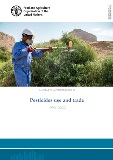Highlights
Pesticides use and trade. 1990–2022
New FAOSTAT data release

Pesticides are a key agricultural input needed to protect seeds and safeguard crops from unwanted plants, insects, bacteria, fungi and rodents. At the same time, pesticides can have negative health and environmental impacts through contamination of soil, water and non-target plants and animals, which can decrease biodiversity and harm living organisms including humans. Statistics of pesticides use and trade are relevant for monitoring the sustainability of agriculture. In particular, they can help assess the global movement of pesticides and identify possible shortcomings in access to markets. The FAOSTAT Pesticides Use database contains data on pesticides use by country, in active ingredients and by major pesticide category, currently for the period 1990–2022.
Main findings:
- In 2022, total pesticides use in agriculture was 3.70 million tonnes (Mt) of active ingredients, marking a 4 percent increase with respect to 2021, a 13 percent increase in a decade, and a doubling since 1990.
- Between 1990 and 2022, pesticides intensities increased at different rates: use per cropland area increased by 94 percent, use per value of agricultural production by 5 percent, and use per person by 35 percent.
- In 2022, the volume of total pesticides exports decreased by 1 percent compared with 2021 to approximately 6.9 Mt of formulated products, but their value increased by 13 percent to USD 48.8 billion.
- In 2022, Asia exported the most pesticides with quantities and values of 3.5 Mt and USD 21.7 billion (2.3 Mt and USD 15.3 billion when considering only exports to other regions).
- In the Americas, pesticides use in agriculture increased by 10 percent from 1.71 Mt in 2021 to 1.89 Mt in 2022.
- Most of Africa’s pesticides imports come from countries outside the region, and the majority of exported pesticides remain in the region.
- Since 1990, pesticides use in Europe fell by 5 percent, with a reduction in the most recent decade by 7 percent.
- The median share of insecticides – biopesticides to total insecticides use in Oceania was 44 percent based on data for four island countries and territories in the region.

